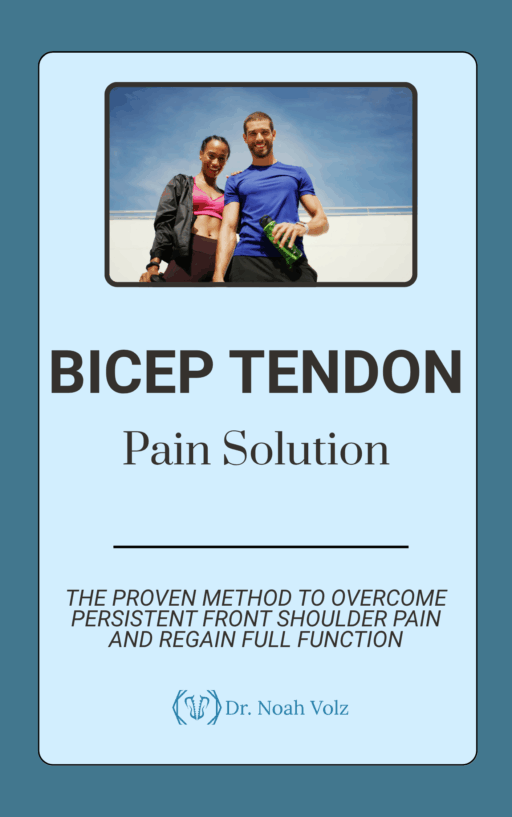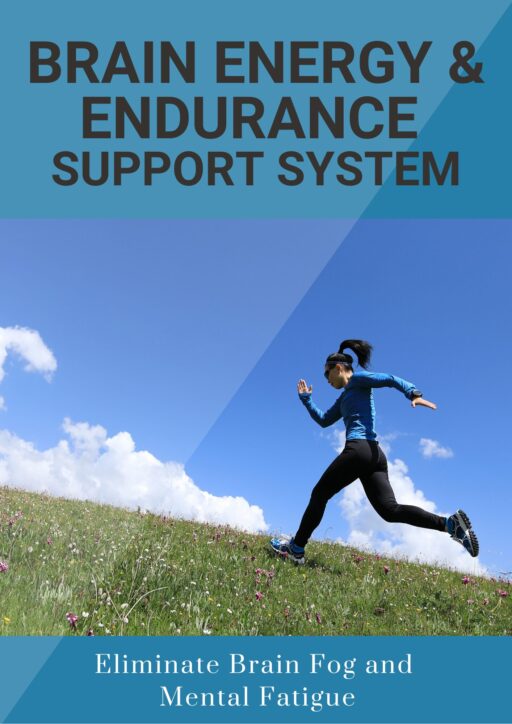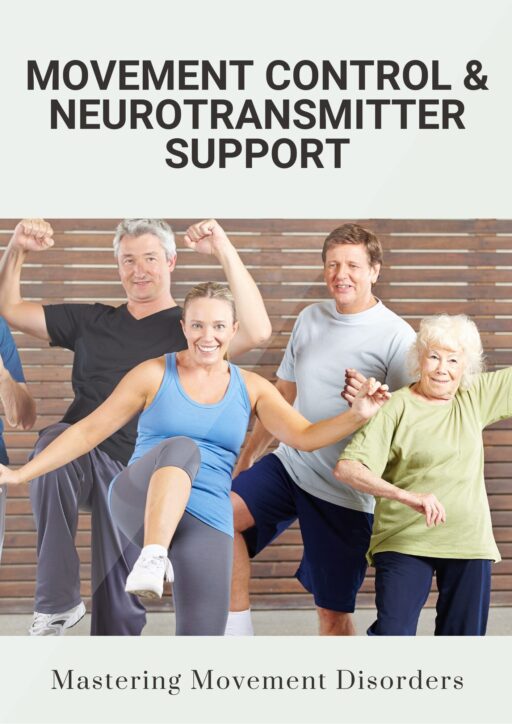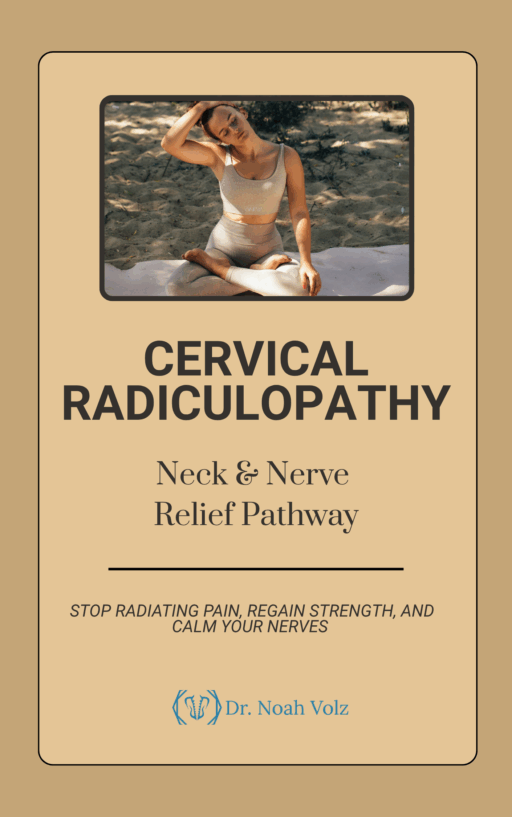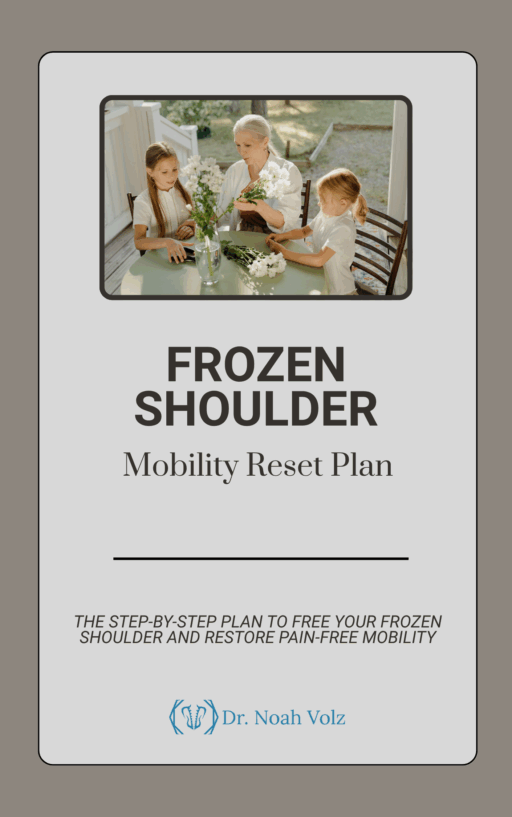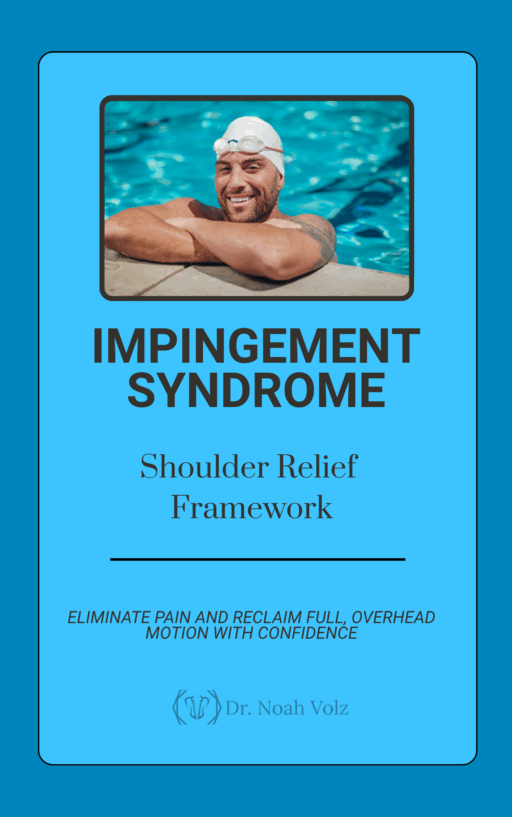Frozen shoulder is as bad as it sounds. Even in medical speak “adhesive capsulitis” sounds bad. No-one wants their shoulder capsule glued with adhesive. What both terms are referring to is an ongoing and painful limitation of movement of the shoulder. (1) There are two types: primary or secondary. (2) Primary refers to frozen shoulder that has no know cause. Secondary refers to frozen shoulder that follows a period of restricted shoulder motion (i.e. rotator cuff pathology, trauma, surgery, etc). (3) Especially if the shoulder undergoes a period of immobilization. (4)
Causes of frozen shoulder
Frozen shoulder goes through stages. (5)
- Stage 1 is characterized by achiness that becomes sharp at end range. The synovium of the glenohumeral joint undergoes inflammation.
- Stage 2 is the “painful” or “freezing” stage that demonstrates a progressive loss of shoulder range of motion. (6) There is often a heightened pain response. (7)
- Stage 3 is the “frozen” stage. The shoulder is frozen and painful. The shoulder goes through progressive fibrosis, capsular thickening, and adhesions in the subarachnoid bursa, subdeltoid bursa, biceps tendon, and intraarticular subscapularis tendon. (8) This can lead to atrophy, degeneration, and permanent motion restrictions.
- Stage 4 is the “thawing” stage where there is decreasing pain and stiffness. It may take up to nine months to regain a functional range of motion.
Frozen shoulder can affect 2-5% of the population. (9) The likelihood of getting a frozen shoulder increases by 10-20% in those with Type 2 diabetes, and 36% in those with Type 1 diabetes. (Patients with thyroid disease are also at an increased risk for developing frozen shoulder. Frozen shoulder is most common in the early fifties and can affect anyone over 40 years old.
Common symptoms of frozen shoulder
Frozen shoulder begins with pain and stiffness that cannot be explained. Secondary frozen shoulder starts following an event (i.e. fall, surgery) or (i.e. rotator cuff pathology, subacromial bursitis, etc). The progressive pain is primarily in the deltoid, with sharp pain at end range motion. (10) Night pain and insomnia are common. There will be limits in your ability to reach overhead, behind the back, or to the side. (11) There will be difficulty washing your hair and reaching behind your back to put on shirts. (12) Often times the pain will plateau for at least a month before the shoulder becomes completely frozen.
The most obvious finding a is a loss of shoulder range of motion. (13) Especially in external rotation, internal rotation, and bringing the arm out to the side. (14) Frozen shoulder is characterized by movement limitations greater than 25% in at least two planes of movement. (33) The most difficult range of motion is external rotation. (15) Especially passive external rotation of the arm. (16) Even though internal rotation may be greater than external rotation. (17) Passively bringing the arm out to the side will not go much higher than the shoulder. (18)
How to evaluate frozen shoulder
There is often more subtle joint motion loss such as translational glide. (19) There could also be biomechanical deficits, including upper crossed syndrome and scapular dyskinesis. Normal shoulder blade movement is responsible for up to 1/3 of total arm elevation and is a factor in frozen shoulder. (20)
Joint restriction in the neck and upper back can contribute to frozen shoulder. Secondary frozen shoulder exhibits positive orthopedic tests associated with rotator cuff pathology (i.e. painful arc, positive Hawkin’s, positive Neer’s, positive empty can). (21)
X-rays can be used to rule out osteoarthritis or dislocation. (22) MRI is appropriate when needed to rule out rotator cuff pathology or if there is no improvement 6-12 weeks. (23) MRI findings wills show axillary recess thickening, joint volume reduction, rotator cuff interval thickening, and proliferative synovitis. (24)
Upper cervical chiropractic for frozen shoulder
The bad news is that there are no overly effective treatments. Manual therapy has shown to improve range of motion, pain, and function. (25) The manual techniques include active and passive stretching of the shoulder capsule with end-range mobilization (26) Shoulder adjustments are also helpful. (27) One such mobilization is gliding the shoulder forward, backward, and downward with the arm overhead. (28) Moving the shoulder blade can also be helpful. Have your chiropractor move the shoulder blade up, down, and to the side. Upper cervical chiropractic can also be helpful in the treatment of shoulder pain and dysfunction. (29)
Frozen shoulder usually lasts up to 18 months with motion deficits in at least 10% of patients. (30) In some instances, it can last for years. (31) You must understand that to limit apprehension and frustration. If there is no improvement after 6 months to a year, then medical and/or surgical management can be utilized. Corticosteroid drugs can be used corticosteroid injections, combined with manual therapy will improve short-term pain relief. (32) Manipulation under anesthesia is another treatment option for persistent cases. (33) Surgical management is selective arthroscopic release. (34)
Exercises to help heal frozen shoulder
Conclusion
If frozen shoulder is a part of your life and you are looking for an answer then I can help. I can help figure out what the cause of the frozen shoulder is. Use chiropractic adjustments and massage to get you out of pain and teach you the exercises you will need in order to build a resilient shoulder that is immune to pain. If you are ready to try this approach schedule with me today. Still looking for more information? Check out my eBook on Chronic Neck Pain.
References
1. Codman EA. The shoulder. Boston, Mass: Thomas Todd; 1934.
2. Lundberg BJ. The frozen shoulder. Clinical and radiographical observations. The effect of manipulation under general anesthesia. Structure and glycosaminoglycan content of the joint capsule. Local bone metabolism. Acta Orthop Scand Suppl. 1969;119:1-59.
3. Malone T, Hazle C. Rehabilitation of adhesive capsulitis. In: Ellenbecker TS, editor. Shoulder rehabilitation. Non-operative treatment. New York: Thieme; 2006.
4. Bruckner FE, Nye CJ. A prospective study of adhesive capsulitis of the shoulder (“frozen shoulder’) in a high risk population. Q J Med. Spring 1981;50(198):191-204.
5. Neviaser AS, Hannafin JA. Adhesive capsulitis: a review of current treatment. Am J Sports Med. 2010;38:2346-2356
6. Kelley MJ, Shaffer MA, Kuhn JE, Michener LA, Seitz AL, Uhl TL, Godges JG, Mcclure PW. Shoulder Pain and Mobility Deficits: Adhesive Capsulitis Clinical Practice Guidelines Linked to the International Classification of Functioning, Disability, and Health From the Orthopaedic Section of the American Physical Therapy Association J Orthop Sports Phys Ther 2013;43(5):A1-A31
7. Hand GC, Athanasou NA, Matthews T, Carr AJ. The pathology of frozen shoulder. J Bone Joint Surg Br. Jul 2007;89(7):928-32.
8. Anton HA. Frozen shoulder. Can Fam Physician. 1993;39:1772–8.
Aydeniz A, Gursoy S, Guney E. Which musculoskeletal complications are most frequently seen in type 2 diabetes mellitus? J Int Med Res. 2008;36:505-511.
9. Fareed DO, Gallivan WR. Office management of frozen shoulder syndrome. Clin Orthop. 1989;242:177–83.
10. Loyd JA, Loyd HM. Adhesive capsulitis of the shoulder: arthrographic diagnosis and treatment. South Med J. 1983;76:879–83.
11. McClure PW, Flowers KR. Treatment of limited shoulder motion: a case study based on biomechanical consideration. Phys Ther. 1992;72(12):929–36.
12. Murnaghan JP. Adhesive capsulitis of the shoulder: current concepts and treatment. Orthopedics. 1988;11(1):153–8.
13. Neviaser JS. Adhesive capsulitis and the stiff and painful shoulder. Orthop Clin North Am. 1980;11:327–31.
14. Parker RD, Rroimson AL, Arsham NZ. Frozen shoulder. Part II: treatment by manipulation under anesthesia. Orthopedics. 1989;12:989–90.
15. Rizk TE, Christopher RP. Adhesive capsulitis (frozen shoulder): a new approach to its management. Arch Phys Med Rehabil. 1983;64:29–33.
16. Rizk TE, Pinals RS. Frozen shoulder. Semin Arthritis Rheum. 1982;11:440–51. doi: 10.1016/0049-0172(82)90030-0.
17. Tveita EK, Sandvik L, Ekeberg OM, Juel NG, Bautz-Holter E. Factor structure of the Shoulder Pain and Disability Index in patients with adhesive capsulitis. BMC Musculoskelet Disord. Jul 17 2008;9:103.
18. Tasto JP, Elias DW. Adhesive capsulitis. Sports Med Arthrosc. Dec 2007;15(4):216-21.
19. Hand C, Clipsham K, Rees JL, Carr AJ. Long-term outcome of frozen shoulder. J Shoulder Elbow Surg. Mar-Apr 2008;17(2):231-6.
22. Tighe CB, Oakley WS Jr. The prevalence of a diabetic condition and adhesive capsulitis of the shoulder. South Med J. Jun 2008;101(6):591-5.
23. Balci N, Balci MK, Tüzüner S. Shoulder adhesive capsulitis and shoulder range of motion in type II diabetes mellitus: association with diabetic complications. J Diabetes Complications. 1999;13:135-140
24. Milgrom C, Novack V, Weil Y, Jaber S, Radeva-Petrova DR, Finestone A. Risk factors for idiopathic frozen shoulder. Isr Med Assoc J. 2008;10:361-364
25. Griggs SM, Ahn A, Green A. Idiopathic adhesive capsulitis. A prospective functional outcome study of nonoperative treatment. J Bone Joint Surg Am. 2000;82-A:1398-1407.
27. Pal B, Anderson J, Dick WC, Griffiths ID. Limitation of joint mobility and shoulder capsulitis in insulin- and non-insulin-dependent diabetes mellitus. Br J Rheumatol. 1986;25:147-151.
28. Sheridan MA, Hannafin JA. Upper extremity: emphasis on frozen shoulder. Orthop Clin North Am. 2006;37:531-539
29. Binder AI, Bulgen DY, Hazleman BL, Roberts S. Frozen shoulder: a long-term prospective study. Ann Rheum Dis. 1984;43:361-364.
30. Schmitt JS, Di Fabio RP. Reliable change and minimum important difference (MID) proportions facilitated group responsiveness comparisonsusing individual threshold criteria.J Clin Epidemiol. 2004;57:1008-1018.
31. Hannafin JA, Chiaia TA. Adhesive capsulitis. A treatment approach. Clin Orthop Relat Res. 2000:95-109
33. Binder AI, Bulgen DY, Hazleman BL, Tudor J, Wraight P. Frozen shoulder: an arthrographic and radionuclear scan assessment. Ann Rheum Dis. 1984;43:365-369.
34. Harryman DT, Sidles JA, Harris SL, Matsen FA. The role of the rotator interval capsule in passive motion and stability of the shoulder. JBJS (Am) 1992; 74:56.
-

Bicep Tendon Pain Solution
$50.00 -

Brain Detoxification & Recovery System
$50.00 -

Brain Energy and Endurance Support System
$50.00 -

Brain-Based Movement and Motor Control Training
$50.00 -

Centralized Low Back Pain
$50.00 -

Cervical Radiculopathy: Neck and Nerve Relief Pathway
$50.00 -

Complex Low Back Pain
$50.00 -

Complex Radiating Low Back Pain
$50.00 -

Cross-Pattern Low Back Pain
$50.00 -

Frozen Shoulder Mobility Reset Plan
$50.00 -

Impingement Syndrome: Shoulder Relief Framework
$50.00 -

Mastering Brain Senses: Rebuild Your Hearing, Vision, and Body Awareness
$50.00


